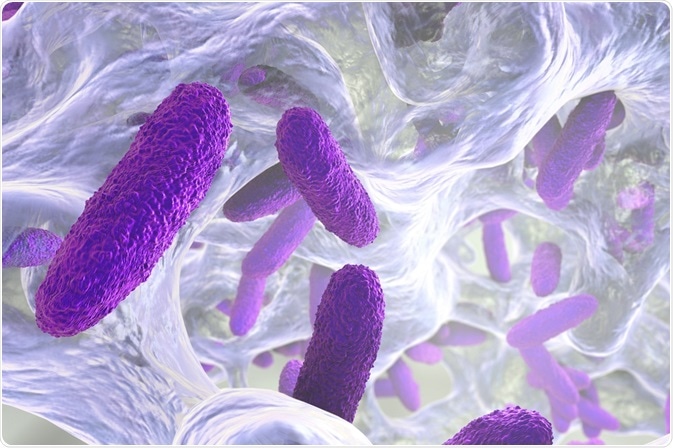Biofilms can be described as accumulations of microbial cells which are encompassed in a matrix of polysaccharides (starchy, sugar-like substances).
 Credit: Kateryna Kon/Shutterstock.com
Credit: Kateryna Kon/Shutterstock.com
In 1684, the Dutch scientist and businessman, Antonie van Leeuwenhoek stated in a report to the Royal Society of London that he had observed colonies of microorganisms in dental plaque. Due to this observation, he was credited with the discovery of biofilms.
As microbial cells are present in a plethora of environmental niches, biofilms can be found almost everywhere; from drainage systems to the lungs of patients with cystic fibrosis. Microorganisms have adapted this lifestyle so that they are able to protect themselves from changes in their external environment which threaten their existence.
Biofilm formation
For free swimming or planktonic cells, the formation of biofilms presents the opportunity for survival in hostile environments. Changes in gene expression due to environmental stressors cause planktonic cells to associate with a surface through appendages such as flagella, pili or lipopolysaccharides.
Through a process known as quorum sensing these microbial cells are able to communicate with one another, enabling them to adapt and coordinate their behaviour.
The newly attached microbial cells coat the surface with a polysaccharide known as extracellular polymeric substance (EPS). The microbial community relies critically on EPS as it behaves like a molecular adhesive; allowing the bacteria to bind to the surface irreversibly as well as to one another.
The polysaccharide matrix protects biofilms against phagocytic cells and provides nutrients for the organisms within the biofilm.
Once the initial layer of the biofilm has formed, the microorganisms within the biofilm undergo a period of growth in which more layers of EPS are formed and the total number of microbial cells increases exponentially. Parts of the biofilm can slough off through a process known as biofilm dispersal, allowing them to colonize new sites.
Biofilms in a clinical setting
Biofilms can cause significant problems in clinical environments as they are able transfer resistant plasmids and conceal pathogenic microorganisms within their dynamic community.
Medical devices such as pacemakers and catheters are susceptible to the formation of biofilms on their surfaces. This can lead to healthcare-associated infections which, due to the nature of biofilms, are difficult to treat with antimicrobial therapies.
Chronic infections caused by biofilms are common. For patients with cystic fibrosis (CF) bacterial infections are the primary cause of illness and mortality. The gram-negative bacteria, Pseudomonas aeruginosa, is the main pathogen which colonizes the lungs of patients with CF.
Even with the use of antibiotics, these bacteria are able to continually form biofilm communities in the lungs of these patients. This often results in life-long treatment.
The use of silver coated surfaces in medical devices is a commonplace approach to preventing biofilm formation on medical devices. The silver in the devices’ surfaces delay and reduce microbial colonization.
Quorum sensing inhibitors may also be used in the prevention of biofilm colonization. They increase the susceptibility of biofilms to antimicrobial treatments and recent studies have shown their efficacy in disrupting P.aeruginosa biofilms.
The control of healthcare associated infections is closely linked to the reduction biofilms in clinical settings. Though methods of prevention exist, the disruption of biofilms on biotic surface as well as the synthetic surfaces of medical devices remains an uphill task. Many questions about survival and proliferation of biofilms still need to be answered.
Sources:
- Donlan, R. (2001). Biofilm Formation: A Clinically Relevant Microbiological Process. Clinical Infectious Diseases, 33(8), pp.1387-1392.
- Donlan, R. (2002). Biofilms: Microbial Life on Surfaces. Emerging Infectious Diseases, 8(9), pp.881-890.
- Francolini, I. and Donelli, G. (2010). Prevention and control of biofilm-based medical-device-related infections. FEMS Immunology & Medical Microbiology, 59(3), pp.227-238.
- Kostakioti, M., Hadjifrangiskou, M. and Hultgren, S. (2013). Bacterial Biofilms: Development, Dispersal, and Therapeutic Strategies in the Dawn of the Postantibiotic Era. Cold Spring Harbor Perspectives in Medicine, 3(4), pp.a010306-a010306.
- Li, Y. and Tian, X. (2012). Quorum Sensing and Bacterial Social Interactions in Biofilms. Sensors, 12(3), pp.2519-2538.
- Limoli, D., Wozniak, D. and Jones, C. (2015). Bacterial Extracellular Polysaccharides in Biofilm Formation and Function. Microbial Biofilms, 2nd Edition, pp.223-247.
- Percival, S., Suleman, L., Vuotto, C. and Donelli, G. (2015). Healthcare-associated infections, medical devices and biofilms: risk, tolerance and control. Journal of Medical Microbiology.
- The University of Nottingham (2018). What is QS?
Further Reading
- All Biofilms Content
- Biofilms in Human Disease
- Biofilm Analysis: Tools and Techniques
- All Microbiology Content
- Gram Negative Bacteria
Last Updated: Aug 23, 2018

Written by
Maryam Mahdi
Maryam is a science writer with a passion for travel. She graduated in 2012 with a degree in Biomedical Sciences (B.Sc.) from the University of Manchester. Maryam previously worked in scientific education and has produced articles, videos, and presentations to highlight the association between dietary choices and cancer. She produces a range of articles for News-Medical, with a focus on microbiology and microscopy.
Source: Read Full Article
